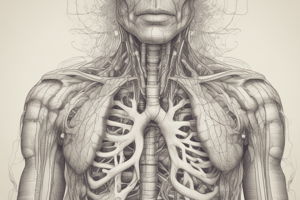Podcast
Questions and Answers
What is pleural effusion primarily characterized by?
What is pleural effusion primarily characterized by?
- Inflammation of the lung tissue
- Absence of fluid in the pleural space
- Abnormal accumulation of pleural fluid (correct)
- Accumulation of air in the pleural cavity
Which of the following is NOT a listed cause of pleural effusion?
Which of the following is NOT a listed cause of pleural effusion?
- Pneumothorax (correct)
- Malignancy
- Tuberculosis
- Congestive heart disease
How many lobes does the right lung have?
How many lobes does the right lung have?
- Five lobes
- Three lobes (correct)
- Two lobes
- Four lobes
Which muscle is primarily responsible for inspiration?
Which muscle is primarily responsible for inspiration?
What distinguishes the left lung from the right lung?
What distinguishes the left lung from the right lung?
What condition may result from a significant accumulation of fluid in the pleural cavity?
What condition may result from a significant accumulation of fluid in the pleural cavity?
What structure is located behind the nasal cavities?
What structure is located behind the nasal cavities?
Which function is primarily associated with the larynx?
Which function is primarily associated with the larynx?
What is the main function of the alveoli in the respiratory system?
What is the main function of the alveoli in the respiratory system?
Which cartilage is NOT a main cartilage of the larynx?
Which cartilage is NOT a main cartilage of the larynx?
Where does the trachea begin?
Where does the trachea begin?
What structure contains the piriform fossa?
What structure contains the piriform fossa?
Which bronchus is wider, shorter, and more vertical?
Which bronchus is wider, shorter, and more vertical?
What is the space between the visceral and parietal pleurae called?
What is the space between the visceral and parietal pleurae called?
Which structure in the respiratory system is responsible for gas exchange?
Which structure in the respiratory system is responsible for gas exchange?
What is the primary function of the nasal cavity?
What is the primary function of the nasal cavity?
Which part of the respiratory system is NOT included in the upper respiratory tract?
Which part of the respiratory system is NOT included in the upper respiratory tract?
What condition is characterized by bleeding from the nose?
What condition is characterized by bleeding from the nose?
Which of the following paranasal sinuses is located in the frontal bone?
Which of the following paranasal sinuses is located in the frontal bone?
How many parts is the pharynx divided into?
How many parts is the pharynx divided into?
Which structure helps in the resonance of voice?
Which structure helps in the resonance of voice?
What is a common cause of sinusitis?
What is a common cause of sinusitis?
Flashcards are hidden until you start studying
Study Notes
Components of the Respiratory System
- Includes the nasal cavity, air sinuses, pharynx, larynx, trachea, bronchi, lungs, and alveoli.
Function of the Respiratory System
- Facilitates gas exchange, allows for the sense of smell, and enables voice production.
Upper Respiratory Tract
- Comprises the nasal cavity, pharynx, larynx, and air sinuses.
Lower Respiratory Tract
- Consists of the trachea, bronchi, bronchioles, and alveoli.
Nasal Cavity
- Divided into right and left halves by the nasal septum. Each half has olfactory and respiratory parts.
- Features three conchae: superior, middle, and inferior, which create spaces called meatuses.
- Functions include warming, moistening, and cleaning inspired air.
Paranasal Air Sinuses
- Located in the maxillae, frontal, sphenoid, and ethmoid bones.
- Open into the nasal cavities and help condition inspired air, provide voice resonance, and lighten the skull.
Epistaxis
- Refers to nosebleeds, with common risk factors including vascular issues, infections, inflammation, trauma, and neoplasms.
Sinus Names
- Four paranasal sinuses: Maxillary, Frontal, Sphenoid, Ethmoid.
- Causes of sinusitis include inflammation, allergies, and polyps.
Pharynx
- A muscular tube positioned behind the nasal and oral cavities, divided into three segments: nasopharynx, oropharynx, and laryngopharynx.
Nasopharynx
- Contains the adenoid tonsil and eustachian tube openings, which help equalize pressure in the ear.
Oropharynx
- Situated behind the oral cavity and contains palatine tonsils.
Laryngopharynx
- Located behind the larynx, with the piriform fossa as a common site for lodging foreign objects.
Larynx
- Consists of cartilages, ligaments, membranes, and muscles, with key cartilages including the thyroid, cricoid, and epiglottis.
- Responsible for voice production via vocal cords.
Trachea
- A cartilaginous tube that begins in the neck and divides into right and left bronchi.
- The right bronchus is wider and shorter, while the left is narrower and longer, with both dividing into smaller bronchioles.
Alveoli
- Serve as the functional units of the respiratory system, facilitating gas exchange.
Lungs
- Soft, spongy organs covered by pleurae (visceral and parietal).
- The hilum of the lung transmits bronchi, pulmonary arteries, and veins.
Pleural Effusion
- Characterized by abnormal fluid accumulation in the pleural cavity, generally due to inflammation, tuberculosis, malignancy, or pneumonia.
Pneumothorax
- Occurs when air enters the pleural cavity, often from penetrating wounds.
Hydrothorax and Hemothorax
- Hydrothorax refers to fluid accumulation in the pleural cavity, while hemothorax involves blood collection.
Lung Differences
- Right lung has three lobes, is short and wide, lacking a cardiac notch.
- Left lung has two lobes, is long and narrow, and possesses a cardiac notch.
Muscles of Respiration
- Diaphragm is the primary muscle of inspiration.
- External intercostals aid in inspiration, while internal intercostals facilitate expiration.
Studying That Suits You
Use AI to generate personalized quizzes and flashcards to suit your learning preferences.




